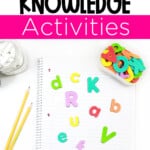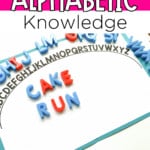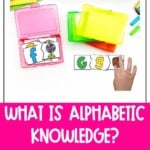


My friend, Lauren, shared this story with me about her daughter. “When my daughter was four, she loved to sing the alphabet. It was fun to jump in with her and sing that very familiar song. She knew the order of the alphabet and some of the sounds each letter makes, but if she got distracted while singing, she couldn’t remember the last letter she had sung and continue on. She had to go back to the beginning and start again.” This was because she was still developing in her alphabetic knowledge.
Even though this skill seems so simple and basic, it’s one of the most foundational literacy skills our readers have. So, what is alphabetic knowledge? How do we help students who haven’t seemed to master it yet? Let’s chat about alphabetic knowledge and why it’s important for our young readers.
Alphabetic knowledge is simply knowledge of the alphabet. It is the ability of the student to instantly recognize the letters of the alphabet, name the letters, alphabet order and structure, know what each letter’s shape is, and know and say the sounds each letter represents. These skills are so important and oftentimes we assume students come to us already knowing them.
*Note: Alphabetic Principle and Alphabetic Knowledge are so closely related that it’s hard to have one without the other, in my opinion. The Alphabetic Principle is the understanding of the relationship between the phonemes and graphemes and is a huge precursor to decoding.
Knowing the alphabet gives teachers and students a common language to discuss letters and their sounds. Students who know their letters with automaticity can then focus on learning the sound(s) the letter makes instead of focusing on recognizing and naming the letter. This skill leads to understanding the alphabetic principle.
There are so many activities you can do in your classroom to help students develop their alphabetic knowledge.
You could have your students sort their magnetic letters on their mats. They could sort by shape, vowels/consonants, place in the alphabet, etc. Once your students are good at putting their letters sequentially on their mat, you can have students identify and say a letter that comes before or after a said letter.
Another activity is to trace the letter while naming it. You can also add in the sound that it represents! Studies have shown that when students trace the letter formation while naming the letter, it helps the knowledge stick.
Next, you can use an alphabet arc. There are so many activities with just this one literacy manipulative! You can have students sequence the letters, identify a missing letter of the alphabet, or match letter tiles/magnetic letters to letters printed on the arc.
Another idea is to think of a letter in your mind and then have your students ask you questions about your letter to guess it. They can try and guess your letter in 10 questions. Some example questions are: “Does this letter have only straight lines?” “Does this letter have curves in it?” “Is it before H in the alphabet?”
Finally, chorally read your alphabet chart together as a class. You can just say the name of the letters, or you can add in the sound(s) each letter makes when your students know the sequence of the alphabet well.
Do you have some students struggling with their knowledge of the alphabet? I have a growing bundle of Science of Reading Literacy Centers that focus on the alphabet, rhyming, syllables, and MORE! These activities are already planned for you!
You’ll be able to keep students engaged in purposeful activities that help build a solid foundation while you are using your science of reading small group curriculum to meet readers where they are!
The Alphabet Centers included in the bundle come with 10 ready-to-go centers to build strong alphabetic knowledge.
Remember that even though this skill may seem simple, don’t assume students have a solid understanding of it. Be sure to teach and review with students until you’re certain they grasp it well.

Want to use the latest research to boost your readers during small groups? This FREE guide is packed with engaging ideas to help them grow!

I’m a K-1 teacher who is passionate about making lessons your students love and that are easy to implement for teachers. Helping teachers like you navigate their way through their literacy block brings me great joy. I am a lifelong learner who loves staying on top of current literacy learning and practices. Here, you’ll find the tools you need to move your K-2 students forward!


| Cookie | Duration | Description |
|---|---|---|
| cookielawinfo-checkbox-analytics | 11 months | This cookie is set by GDPR Cookie Consent plugin. The cookie is used to store the user consent for the cookies in the category "Analytics". |
| cookielawinfo-checkbox-functional | 11 months | The cookie is set by GDPR cookie consent to record the user consent for the cookies in the category "Functional". |
| cookielawinfo-checkbox-necessary | 11 months | This cookie is set by GDPR Cookie Consent plugin. The cookies is used to store the user consent for the cookies in the category "Necessary". |
| cookielawinfo-checkbox-others | 11 months | This cookie is set by GDPR Cookie Consent plugin. The cookie is used to store the user consent for the cookies in the category "Other. |
| cookielawinfo-checkbox-performance | 11 months | This cookie is set by GDPR Cookie Consent plugin. The cookie is used to store the user consent for the cookies in the category "Performance". |
| viewed_cookie_policy | 11 months | The cookie is set by the GDPR Cookie Consent plugin and is used to store whether or not user has consented to the use of cookies. It does not store any personal data. |


